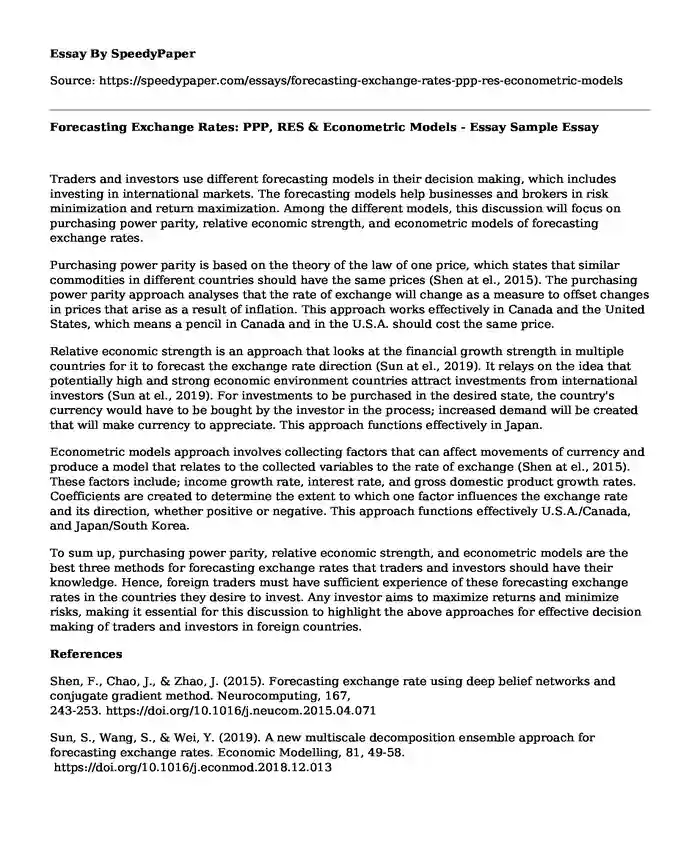Traders and investors use different forecasting models in their decision making, which includes investing in international markets. The forecasting models help businesses and brokers in risk minimization and return maximization. Among the different models, this discussion will focus on purchasing power parity, relative economic strength, and econometric models of forecasting exchange rates.
Purchasing power parity is based on the theory of the law of one price, which states that similar commodities in different countries should have the same prices (Shen at el., 2015). The purchasing power parity approach analyses that the rate of exchange will change as a measure to offset changes in prices that arise as a result of inflation. This approach works effectively in Canada and the United States, which means a pencil in Canada and in the U.S.A. should cost the same price.
Relative economic strength is an approach that looks at the financial growth strength in multiple countries for it to forecast the exchange rate direction (Sun at el., 2019). It relays on the idea that potentially high and strong economic environment countries attract investments from international investors (Sun at el., 2019). For investments to be purchased in the desired state, the country's currency would have to be bought by the investor in the process; increased demand will be created that will make currency to appreciate. This approach functions effectively in Japan.
Econometric models approach involves collecting factors that can affect movements of currency and produce a model that relates to the collected variables to the rate of exchange (Shen at el., 2015). These factors include; income growth rate, interest rate, and gross domestic product growth rates. Coefficients are created to determine the extent to which one factor influences the exchange rate and its direction, whether positive or negative. This approach functions effectively U.S.A./Canada, and Japan/South Korea.
To sum up, purchasing power parity, relative economic strength, and econometric models are the best three methods for forecasting exchange rates that traders and investors should have their knowledge. Hence, foreign traders must have sufficient experience of these forecasting exchange rates in the countries they desire to invest. Any investor aims to maximize returns and minimize risks, making it essential for this discussion to highlight the above approaches for effective decision making of traders and investors in foreign countries.
References
Shen, F., Chao, J., & Zhao, J. (2015). Forecasting exchange rate using deep belief networks and conjugate gradient method. Neurocomputing, 167, 243-253. https://doi.org/10.1016/j.neucom.2015.04.071
Sun, S., Wang, S., & Wei, Y. (2019). A new multiscale decomposition ensemble approach for forecasting exchange rates. Economic Modelling, 81, 49-58. https://doi.org/10.1016/j.econmod.2018.12.013
Cite this page
Forecasting Exchange Rates: PPP, RES & Econometric Models - Essay Sample. (2023, Oct 29). Retrieved from https://speedypaper.net/essays/forecasting-exchange-rates-ppp-res-econometric-models
Request Removal
If you are the original author of this essay and no longer wish to have it published on the SpeedyPaper website, please click below to request its removal:
- Essay Example on Socioeconomic Mobility in UK
- Free Essay on Managing Ambiguity and Change Essay
- Finance Essay Example: Rate of Return Versus Cost of Debt
- Economics Essay Example: Unemployment in Kenya
- Essay Sample on Unethical Accounting Practices
- Free Essay - Employers Plan to Increase Hiring By 5.8% Percent
- Report Sample on Strategic Harmony: Financial Planning, Budgeting, and Departmental Coordination
Popular categories





